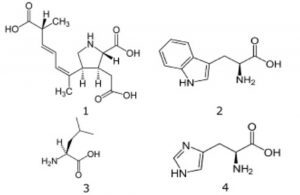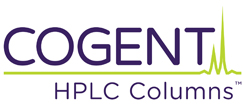Low level Analysis Without Analyte Derivatization
This LCMS Method can achieve very low detection levels of Domoic Acid and Amino Acids without the need for analyte derivatization. Figures A and B show the Chromatograms of both Algae extracts. Figure C shows a zoom-in overlay of both cultures 1 and 2 for the Histidine Peak.
This Method shows how the Tryptophan levels are significantly different between the two cultures whereas the other levels are comparable. The Method also produces sufficient separation of Domoic Acid from Tryptophan, which is often an interferent in Domoic Acid quantitation.


Peaks:
1. Domoic acid 312.1442 m/z (M+H)+
2. L-Tryptophan 205.0972 m/z (M+H)+
3. L Leucine 132.1025 m/z (M+H)+
4. L-Histidine 156.0773 m/z (M+H)+
Method Conditions
Column: Cogent Diamond Hydride™, 4μm, 100Å
Catalog No.: 70000-15P-2
Dimensions: 2.1 x 150mm
Mobile Phase:
—A: 50% DI Water / 50% MeOH / 0.1% Formic Acid
—B: Acetonitrile / 0.1% Formic Acid
Gradient:
| Time (minutes) | %B |
| 0 | 95 |
| 7 | 20 |
| 10 | 20 |
| 11 | 95 |
Post Time: 5 minutes
Flow rate: 0.4mL / minute
Detection: ESI – POS – Agilent 6210 MSD TOF Mass Spectrometer
Injection vol.: 1μL
Sample Preparation: Methanolic extracts of Pseudo-Nitzschia Australis Diatom cultures 1 and 2, isolated by filtration.
t0: 0.9 minutes
Note: Toxic Pseudo-Nitzschia Australis produces the potent neurotoxin Domoic Acid. In 1998, a widespread bloom of these algal species affected the central California coastline and resulted in the mass death of over 400 sea lions. The animals died by the ingestion of shellfish (e.g. mussels) that have fed upon diatom blooms that include toxic species of Pseudo-Nitzschia.
Attachment
No 156 Domoic Acid & Amino Acids in Algae Extracts Analyzed with LCMS .pdf 0.1 Mb Download File


